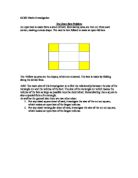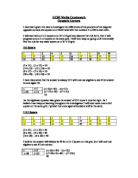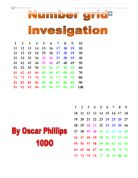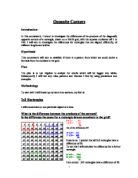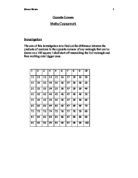Diagonal Difference
Mustafa Rafik 11.7API Maths Coursework-Diagonal Difference Introduction We are given an eight by eight grid. Find the diagonal difference of different size grids (For e.g. 3 by 3, 4 by 4) within the eight by eight grid, by multiplying the opposite corners which results in two answers, we then deduct these two to get a final answer for that size. 2 3 4 5 6 7 8 9 0 1 2 3 4 5 6 7 8 9 20 21 22 23 24 25 26 27 28 29 30 31 32 33 34 35 36 37 38 39 40 41 42 43 44 45 46 47 48 49 50 51 52 53 54 55 56 57 58 59 60 61 62 63 64 Sara writes down a 3 by 3 grid from the above table. 0 1 2 8 9 20 26 27 28 She notices that when you multiply the opposite corners the difference between the products is 32. For example 10 times 28 = 280 12 times 26 = 312 The diagonal difference is 312 - 280 = 32 Aim I have been asked to investigate the diagonal difference of a three by three grid inside an eight by eight grid. I will then try to find a formula which relates to the diagonal difference of each square, I will then further this investigation by trying to find the diagonal difference of a nine by nine grid and a ten by ten grid and find the formula and see if it is the same. I will also do an extension by doing a rectangle instead of a square and then find the diagonal difference and the formula for this. I am going
How can visual illusions illustrate top down processes in perception? Contrast this with a visual illusion that can be explained through bottom up processes.
How can visual illusions illustrate top down processes in perception? Contrast this with a visual illusion that can be explained through bottom up processes. There are many suggestions to explain how visual illusions can be perceived. These suggestions include physical illusions, bottom up illusions and top down illusions. An example of a physical illusion is how a straight stick when placed in water appears bent. Here the illusion has occurred before the light has entered the eye and so is a physical illusion. Bottom up and top down illusions however involve the processing after the light has entered the eye. Bottom up processes are processes which take information into the eye and then make judgements about the nature of the visual world based solely on this information. Hering who suggested that it was the innate ability of the visual system that led to how things were perceived illustrates this. Top down processing however involves using prior knowledge and experience about the structure of the world to influence how something is perceived. Helmholtz who felt that the perception of a stimulus was based on visual experience illustrated this. The following illusions show examples of how both processes can be used to explain perceptions. An example of a visual illusion that can be explained by top down processing is the Muller Lyer illusion (figure 1). In this
The Open Box Problem.
Mathematics GCSE THE OPEN BOX PROBLEM Craig Lochhead 11G Problem I have to find out the volume of a box by using at first a square sheet and then cutting out the corners at any length. The volume of the box will differ to the amount you cut off. I will then try to find the maximum volume of an open square box. After finding the maximum volume of a square I will investigate further using rectangles sheets to cut out square edges. I will also find out the maximum volume of a rectangle sheet as well. I will use formulas and graphs to help me find out the maximum volume of both a rectangle and a square and pick out patterns seen in the tables I will make. (All measurements will be measured in centimetres) Question One This is an example of what I will do. 0x10 cut out size 2cm 20x20 cut out size 3cm 30x30 cut out of 4 cm Question Two Some examples on how cut out will look like in question two 0x20 cut out size 3 0x30 cut out size 4 20x30 cut out size 5 Conclusion All the formulas I found were based on the results and graphs shown. I used both my graphs and results in question 1 to find the maximum cut out size for maximum volume and the formula for the maximum volume if using a square. The reason why I could not find the formula for the maximum cut out size for two lengths is because, using only the results and graphs, it is impossible
The Open Box Problem
The Open Box Problem I am going to investigate the size of the square cut which makes the volume of the box as large as possible for any given rectangular sheet of card. First I am going to investigate the size of the cut out square which makes an open box of the largest volume for any sized square sheet of card. Identical squares are cut off the four corners of the card as shown below. The card is then folded along the dotted lines to make a box. To find volume the following formula is needed: Volume=length x width x height. To investigate the first square sheet of card, I am going to use a square with the length of each side as 18cm². The practical method would be to make a box and obtain the volume from that, and changing the size of the cut out squares for each trial. For the first trial I will use 2cm² cut out squares at each of the four corners of the card. This would leave me with a length of 14cm for each side. Then I would fold along the dotted lines to make an open box as shown above and then calculate the volume. However this is quite a long method and I could calculate the volume using the net instead of constructing the box. However there is an even quicker which I have found which can work out the volume without constructing a box or a net. The length of the cut out square is always the same as the height. Also the length can be calculated by taken the
The Open Box Problem
GCSE Maths Investigation The Open Box Problem An open box is made form a sheet of card. Identical squares are then cut from each corner, making a cross shape. The card is then folded to make an open-lid box. The Yellow squares are the shapes, which are removed. The box is made by folding along the dotted lines. AIM: The main aim of this investigation is to find the relationship between the size of the rectangle cut and the volume of the box. The size of the rectangle cut which makes the volume of the box as large as possible must be determined. Remembering that a square is also a special form of a rectangle. As well as the general aim there are two other aims: . For any sized square sheet of card, investigate the size of the cut out square, which makes an open box of the largest volume. 2. For any sized rectangular sheet of card, investigate the size of the cut out square, which makes an open box of the largest volume. AIM 1 First I will be looking at aim 1 which uses a square sheet of card. A square is being cut from each corner. Aim 1 is to find out what fraction of the whole original square needs to be cut from each corner to make the largest possible volume. This chart shows the volume compared to the 3 different sizes of original card (10cm², 20cm² and 30cm²) and the size of the squares cut out. For each size of A (original piece of card) the volume
the Open Box Problem
THE OPEN BOX PROBLEM Aim: To find out the size of the square cut which makes the volume of the box as large as possible for any square sheet of cards. Prediction: I predict that as the size of the square increases, the volume of the box should also increase. Assumption: Length of the square cut won't go under 1 The length of the squares cut has to be identical The Square Open Box: In this investigation I'm first using a 20x20 square to start with, since it's easier because the area is smaller. To get myself started, I would try to use a trail run. A trail run would help because it can give me the main idea of the investigation. To calculate the volume of an object, we use the formula: Length x Width x Height To find the volume of the square box, we first need the length and width of the base, which is the middle square in the sheet. Then we need the height, which is the length of the identical squares (yellow squares) when folded. After these decisions, I came up with this formula. Volume = x (l-2x)(w-2x) I minus both the length and the width by two because I need the length and width of the middle square, not the whole square sheet. To get that, I need to get rid of the yellow square's lengths. These together will give me the area of the base. Next, I time the base area by x, which is the height to get the volume of the box. Example: x = 2 20X20
Maths Coursework
Introduction: The task we have been set for this piece of coursework is to investigate numbers presented in a number grid. A box is placed around 4 of the number and the question asked was to find the product of the top left number and the bottom right number. This solution was then taken away from the top right number and the bottom left number like this: 2 3 22 23 (13 x 22)-(12 x23) = 10 Aim: My aim in this coursework is to experiment using 3 different variables in boxes. These will be: size, shape and size of grid. I will investigate boxes that are the same size, bigger, smaller, in different proportions and those that are different in shape. What I mean by this is that I will take boxes of the following proportions: 2x2, 3x3, 4x4, 5x5, 2x3, 2x4, 2x5, 3x4, 3x5, 4x5. I will take 4 boxes of each of type of the above that are squares. I will take these results by using the random function on my calculator. The figure given will be any number in the box. Investigation: 2x2 boxes: My first boxes that I will be investigating are the 2x2 boxes of which I am taking 4. Theses are the boxes I have taken: : 35 36 45 46 (36x45)-(35x46) = 10 2: 57 58 67 68 (58x67)-(57x68) = 10 3: 88 89 98 99 (89x98)-(88x99) = 10 4: 42 43 52 53 (43x52)-(42x53) = 10 Lorenzo Brusini Proving algebraically the 2x2 boxes: For my prediction of this the 2x2 boxes, I
Maths - number grid
Chapter One For the first part of my maths G.C.S.E coursework I have been provided with a 10x10 number grid, which is numbered 1 to 100. I have been instructed to find the product of the top left number and the bottom right number and the same with the top right and bottom left number within selected squares used. I am going to use this grid to examine at random various sizes of squares and rectangles. My objective here is to establish a trend to identify an overall formula. I am firstly going to examine a series of 2x2 squares the primary one I will look at has been outlined in the number grid I was provided with, I will then select alternative 2x2 squares at random from the grid. ) 13x22 - 12x23 286 - 276 Difference = 10 58x67- 57x68 2) 3886 - 3876 Difference = 10 3) 35x44 - 34x45 1540 - 1530 Difference = 10 By looking at the three 2x2 squares chosen above it is possible to see each time that there is a difference of 10. So in conclusion to this I can say that any further investigations using 2x2 squares will always result in a difference of 10. Looking at my results and the number grid at this stage, I feel I can suggest that the reason I may get the same result of 10 each time is one of two small theories, my first one being that it is possible to see that the
Number Grid
Number Grid For this piece of coursework I have been asked to identify the connections between calculating the top numbers in a square sized grid with the bottom numbers. This is to identify what connections there are for the four sets of numbers. This is the 10 x 10 number grid, which I will use to investigate the products of the top and bottoms numbers when multiplied. 2 3 4 5 6 7 8 9 0 1 2 3 4 5 6 7 8 9 20 21 22 23 24 25 26 27 28 29 30 31 32 33 34 35 36 37 38 39 40 41 42 43 44 45 46 47 48 49 50 51 52 53 54 55 56 57 58 59 60 61 62 63 64 65 66 67 68 69 70 71 72 73 74 75 76 77 78 79 80 81 82 83 84 85 86 87 88 89 90 91 92 93 94 95 96 97 98 99 00 This is achieved through the following rule: * A box is drawn around four numbers * The top left number is multiplied with the bottom right number to find the product * Then the top right number is multiplied with the bottom left number to find the product * Then through calculating these products the difference will be attained For example 2 x2 Grid 2 13 22 23 2 x 23 = 276 The difference from the two products are 10. 3 x 22 = 286 This is how I worked the difference out: 286-276 = 10 From this example I can now form my hypothesis, which in this case is a statement. I will aim to either prove my hypothesis correct
Number Grid
Number Grid 2 3 4 5 6 7 8 9 0 1 2 3 4 5 6 7 8 9 20 21 22 23 24 25 26 27 28 29 30 31 32 33 34 35 36 37 38 39 40 41 42 43 44 45 46 47 48 49 50 51 52 53 54 55 56 57 58 59 60 61 62 63 64 65 66 67 68 69 70 71 72 73 74 75 76 77 78 79 80 81 82 83 84 85 86 87 88 89 90 91 92 93 94 95 96 97 98 99 00 First of all we need to pick a box of numbers. Like the one shown on the diagram above. This will then be used to find the product of the top left and the bottom right number in this box. 2(n) 3(n+1) 22(n+9) 23(n+11) This shows the top left number as the lowest number which will then be multiplied against the bottom right number to find the product of the two numbers. 2 x 23 = 276 Then we need to get the product of the top right and the bottom right number to see if there is any difference in the two numbers and then see if there is any pattern or general rule to gain from this box/shape. We will be using the top right number multiplied against the bottom left number. 3 x 22 = 286 As you can see there is a difference of 10 between these two numbers, but to see if this is correct with all the other boxes in the square I will check it with another random box. 57(n) 58(n+1) 67(n+9) 68(n+11) We will follow the same method and times the top left with the bottom right first then the






